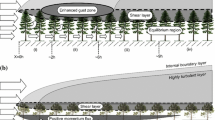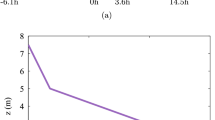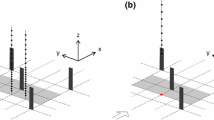Abstract
Sharp heterogeneities in forest structure, such as edges, are often responsible for wind damage. In order to better understand the behaviour of turbulent flow through canopy edges, large-eddy simulations (LES) have been performed at very fine scale (2 m) within and above heterogeneous vegetation canopies. A modified version of the Advanced Regional Prediction System (ARPS), previously validated in homogeneous conditions against field and wind-tunnel measurements, has been used for this purpose. Here it is validated in a simple forest-clearing-forest configuration. The model is shown to be able to reproduce accurately the main features observed in turbulent edge flow, especially the “enhanced gust zone” (EGZ) present around the canopy top at a few canopy heights downwind from the edge, and the turbulent region that develops further downstream. The EGZ is characterized by a peak in streamwise velocity skewness, which reflects the presence of intense intermittent wind gusts. A sensitivity study of the edge flow to the forest morphology shows that with increasing canopy density the flow adjusts faster and turbulent features such as the EGZ become more marked. When the canopy is characterized by a sparse trunk space the length of the adjustment region increases significantly due to the formation of a sub-canopy wind jet from the leading edge. It is shown that the position and magnitude of the EGZ are related to the mean upward motion formed around canopy top behind the leading edge, caused by the deceleration in the sub-canopy. Indeed, this mean upward motion advects low turbulence levels from the bottom of the canopy; this emphasises the passage of sudden strong wind gusts from the clearing, thereby increasing the skewness in streamwise velocity as compared with locations further downstream where ambient turbulence is stronger.
Similar content being viewed by others
References
Belcher SE, Jerram N and Hunt JC (2003). Adjustment of a turbulent boundary layer to a canopy of roughness elements. J Fluid Mech 488: 369–398
Chen JMT, Novak MD, Adams R (1995) A wind tunnel study of turbulent air flow in forest clearcuts. In: Coutts MP, Grace J (eds) Wind and Tress. Cambridge University Press, pp 71–97
Cleugh HA and Hughes DE (2002). Impact of shelter on crop microclimates: a synthesis of results from wind tunnel and field experiments. Austr J Experi Agric 42: 679–701
Dupont S and Brunet Y (2006). Simulation of turbulent flow in an urban forested park damaged by a windstorm. Boundary-Layer Meteorol 120: 133–161
Finnigan JJ (2000). Turbulence in plant canopies. Annu Rev Fluid Mech 32: 519–571
Flesch TK and Wilson JD (1999). Wind and remnant tree sway in forest cutblocks. I. Mesaured winds in experimental cutblocks. Agric For Meteorol 93: 229–242
Foudhil H, Brunet Y and Caltagirone J-P (2005). A k−ε model for atmospheric flow over heterogeneous landscapes. Env Fluid Mech 5: 247–265
Garratt JR (1990). The internal boundary layer—a review. Boundary-Layer Meteorol 50: 171–203
Gash JHC (1986). Observations of turbulence downwind of a forest-heath interface. Boundary-Layer Meteorol 36: 227–237
Green SR (1992). Modelling turbulence air flow in a stand of widely-spaced trees. PHOENICS, J Comp Fluid Dyn Applic 5: 294–312
Irvine MR, Gardiner BA and Hill MK (1997). The evolution of turbulence across a forest edge. Boundary-Layer Meteorol 84: 467–496
Judd MJ, Raupach MR and Finnigan JJ (1996). A wind tunnel study of turbulent flow around single and multiple windbreaks, part I: velocity fields. Boundary-Layer Meteorol 80: 127–165
Kanda M and Hino M (1994). Organized structures in developing turbulent flow within and above a plant canopy, using a large eddy simulation. Boundary-Layer Meteorol 68: 237–257
Lee X (2000). Air motion within and above forest vegetation in non-ideal conditions. For Ecol Manage 135: 3–18
Li Z and Lin JD (1990). Air flow over and through a forest edge: a steady-state numerical simulation. Boundary-Layer Meteorol 51: 179–197
Liu J, Chen JM, Black TA and Novak MD (1996). k−ε modelling of turbulent air flow downwind of a model forest edge. Boundary-Layer Meteorol 77: 21–44
McNaughton KG (1989). Micrometeorology of shelter belts and forest edges. Phil Trans Roy Soc Lond 324: 351–368
Morse AP, Gardiner BA and Marshall BJ (2002). Mechanisms controlling turbulence development across a forest edge. Boundary-Layer Meteorol 103: 227–251
Nieveen JP, El-Kilani RMM and Jacobs AFG (2001). Behaviour of the static pressure around a tussock grassland-forest interface. Agric For Meteorol 106: 253–259
Patton EG, Shaw RH, Judd MJ and Raupach MR (1998). Large-eddy simulation of windbreak flow. Boundary-Layer Meteorol 87: 275–306
Pénelon T, Calmet I and Mironov DV (2001). Micrometeorological simulations over a complex terrain with SUBMESO: a model study using a novel pre-processor. Int J Environ Pollut 16: 583–602
Raynor GS (1971). Wind and temperature structure in a coniferous forest and a contiguous field. For Sci 17: 351–363
Raupach MR, Bradley EF, Ghadiri H (1987) A wind tunnel investigation into aerodynamic effect of forest clearings on the nesting of abbott’s Boody on Christmas Island. Internal report, CSIRO Centre for environmental Mechanics, Canberra, 21 pp
Raupach MR, Finnigan JJ and Brunet Y (1996). Coherent eddies and turbulence in vegetation canopies: the mixing-layer analogy. Boundary-Layer Meteorol 78: 351–382
Sellier D and Fourcaud T (2005). A mechanical analysis of the relationship between free oscillations of pinus pinaster Ait saplings and their aerial architecture. J Exper Bot 56: 1563–1573
Shaw RH, Hartog D and Neumann HH (1988). Influence of foliar density and thermal stability on profiles of Reynolds stress and turbulence intensity in a deciduous forest. Boundary-Layer Meteorol 45: 391–409
Shaw RH and Schumann U (1992). Large-eddy simulation of turbulent flow above and within a forest. Boundary-Layer Meteorol 61: 47–64
Somerville A (1980). Wind stability: forest layout and silviculture. NZ J Forest Sci 10: 476–501
Su H-B, Shaw RH, Paw UKT, Moeng C-H and Sullivan PP (1998). Turbulent statistics of neutrally stratified flow within and above a sparse forest from large-eddy simulation and field observations. Boundary-Layer Meteorol 88: 363–397
Su H-B, Shaw RH and Paw UKT (2000). Two-point correlation analysis of neutrally stratified flow within and above a forest from large-eddy simulation. Boundary-Layer Meteorol 94: 423–460
Watanabe T (2004). Large-eddy simulation of coherent turbulence structures associated with scalar ramps over plant canopies. Boundary-Layer Meteorol 112: 307–341
Wang H and Takle ES (1995). A numerical simulation of boundary-layer flows near shelterbelts. Boundary-Layer Meteorol 75: 141–173
Wilson JD and Flesch TK (1999). Wind and remnant tree sway in forest cutblocks. III. A windflow model to diagnose spatial variation. Agric For Meteorol 93: 259–282
Xue M, Droegemeier KK, Wong V, Shapiro A, Brewster K (1995) ARPS version 4.0 user’s guide. University of Oklahoma, Norman, OK, Center for Analysis and Prediction of Storms, 380 pp
Xue M, Droegemeier KK and Wong V (2000). The advanced regional prediction system (ARPS)—a multi-scale nonhydrostatic atmospheric simulation and prediction model. Part I: model dynamics and verification. Meteorol Atmos Phys 75: 161–193
Xue M, Droegemeier KK, Wong V, Shapiro A, Brewster K, Carr F, Weber D, Liu Y and Wang D (2001). The advanced regional prediction system (ARPS)—a multi-scale nonhydrostatic atmospheric simulation and prediction tool. Part II: model physics and applications. Meteorol Atmos Phys 76: 143–165
Yang B, Raupach M, Shaw RH, Paw UKT and Morse AP (2006a). Large eddy simulation of turbulent flow across a forest edge Part I: flow statistics. Boundary-Layer Meteorol 120: 377–412
Yang B, Morse AP, Shaw RH and Paw UKT (2006b). Large eddy simulation of turbulent flow across a forest edge Part II: momentum and turbulence kinetic energy budgets. Boundary-Layer Meteorol 121: 433–457
Author information
Authors and Affiliations
Corresponding author
Rights and permissions
About this article
Cite this article
Dupont, S., Brunet, Y. Edge Flow and Canopy Structure: A Large-Eddy Simulation Study. Boundary-Layer Meteorol 126, 51–71 (2008). https://doi.org/10.1007/s10546-007-9216-3
Received:
Accepted:
Published:
Issue Date:
DOI: https://doi.org/10.1007/s10546-007-9216-3




